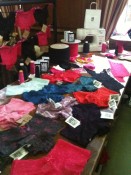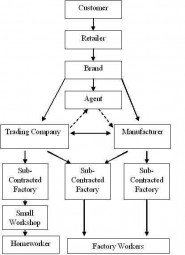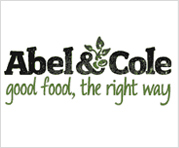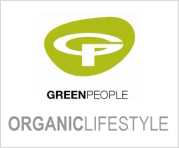Who made your outfit…and those lacy pants?
 When it comes to clothes I love a bit of swishing and charity shop hunting so when it comes to indulging in a bit of shopping, underwear is my purchase of choice. Finding beautiful and eco-friendly underwear is very difficult so it was great to see some underwear brands at The Good Fashion Show. One which particularly stood out was Who Made Your Pants.
When it comes to clothes I love a bit of swishing and charity shop hunting so when it comes to indulging in a bit of shopping, underwear is my purchase of choice. Finding beautiful and eco-friendly underwear is very difficult so it was great to see some underwear brands at The Good Fashion Show. One which particularly stood out was Who Made Your Pants.
Who Made Your Pants is a company based in Southampton that produces lacy knickers. They buy end of season lace from the lingerie industry. The amount available varies from lace to lace and although they have perfected one classic style the same sewing pattern cannot always be used.
Have you ever tried on the same dress in two different colours and wondered why they don’t fit the same? Certain fabrics react differently to different dyes and lace is susceptible to this. In addition the different lace designs alter the properties of the lace meaning a new pattern is needed for some laces. The main idea behind the brand is visibility of the supply chain which extends to telling the customer who made their pair of knickers and details of the machinists are on the website.
This brings me onto the theme of traceability brought up at one of the keynote speaker talks. The supply chain of any retailer is typically long and ever changing. Lord Anthony Young , Vice-Chair of the Ethical Trading Initiative (ETI) noted how it is vital to get ‘buy-in’ on ethical trade from upper levels of management. These people instigate projects but are also important in terms of ensuring buying practices in the company do not undermine ethical trading targets.
 It is important to embed an ethical trading culture throughout the company and to all employees as they are the ones who manage day-to-day trading activities. The first step towards ethical practices is to know who made the clothing something which is not always easy when there can be many levels in the supply chain. But building a true picture requires mutual trust; potentially a difficult thing to achieve.
It is important to embed an ethical trading culture throughout the company and to all employees as they are the ones who manage day-to-day trading activities. The first step towards ethical practices is to know who made the clothing something which is not always easy when there can be many levels in the supply chain. But building a true picture requires mutual trust; potentially a difficult thing to achieve.
Government regulation was suggested as an avenue to take given that voluntary action was not forthcoming in delivery results. One of the main barriers to this would be that regulation requires enforcement. And regulations require a much deeper understanding of the complex task of achieving ethical conditions throughout the supply chain.
Retailers at the top are ultimately the key to improving worker conditions further down in the supply chain. Any kind of government enforcement is a long way off and it is up to retailers to act responsibly and take the journey towards ethical trading.
By Laura Russell
Women
A wide selection of stylish fashion clothing for all occasions including: dresses, tops, knitwear, skirts, eveningwear, coats, suits, jackets and more. Styles to suit a variety of tastes from classic to vintage and more in between: recycled and upcycled. This is sustainable ethical fashion at it's best.
Women's Ethical ClothingMen
If you're looking for something eco or ethical to wear for dress down friday, a casual weekend or holiday, you'll find it here. Tops, t-shirts, jeans, trousers from mainly fairtrade and organic cotton.
Men's Ethical FashionKids
Green fashion for kids is fun and made mainly from natural fibres including organic cotton and Fairtrade cotton. From baby to early teens, there's something to make all kids happy. Bright colours, animals, fun shapes that children can wear all year round.
Kids Green ClothingAccessories
A treasure trove of accessories from around the world can be found here. A vast selection of jewellery including necklaces, bracelets, rings and earrings to shoes, hats, bags, handbags and scarves. Whatever your style, these items will complete any outfit.
Eco-Friendly Accessories





Comments are closed.